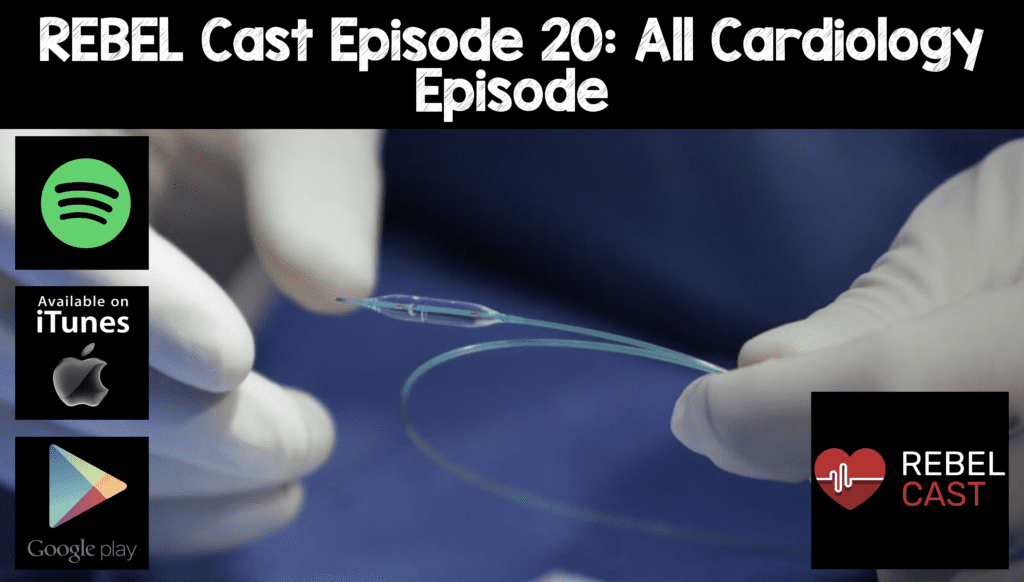
Topic #1: Reducing Door to Balloon (D2B) Times to <90 Minutes in STEMI
Topic #2: Continuous vs Interrupted CPR in OHCA
REBEL Cast Episode 20: All Cardiology Episode
Click here for Direct Download of Podcast
Topic #1: Using Aggressive Measures to Decrease “Door to Balloon” Time
Background: We all know the old adage of “Time is Muscle,” when it comes to management of acute STEMI. Many hospitals have door to balloon (DTB) committees in place to help decrease the time from hospital arrival to onset of reperfusion therapy. A benchmark set by the American College of Cardiology/American Heart Association guidelines is a DTB time of less than 90 minutes for patients presenting with STEMI. There are pressures to decrease these times to even less than 90 minutes, but with less time come more rapid triage decisions with faster dispatches to the catheterization laboratory which may come at an expense of increased false positive STEMI diagnoses and ultimately worse patient outcomes.
Question: Do aggressive interventions to reduce the door-to-balloon times result in improved patient outcomes?
What They Did:
- A Single Center trial of 1031 consecutive patients with presumed STEMI and confirmed ST-segment elevation who underwent emergent catheterization
- Instituted an aggressive protocol to reduce door to balloon time
- Outcomes were compared before and after initiation of quality improvement measures
- Quality Improvement Initiatives Included:
- Hospital arrival to electrocardiography (ECG) time of <5minute
- Immediate contact with an interventionalist (<5minutes)
- After-hours arrival of staff to catheterization laboratory within 30 minutes
- An overall DTB time of <60 minutes
- Real-time feedback and notes of appreciation given to all the staff involved in cases
Outcomes:
- Door to Balloon Time
- Incidence of False Positive STEMI
- In-Hospital Morality
Results:
- Median Door to Balloon Time decreased from 76 min to 61 min (p = 0.001)
- Increased False Positive STEMI Activations (7.7% vs 16.5%; p = 0.02)
- 170/1031 (16.5%) False Positive STEMI’s Activated
- Non-Significant reduction of in-hospital mortality in patients with true-positive STEMI (p = 0.60)
- Significant increase in in-hospital mortality seen in patients with False Positive STEMI (5.6% to 21.6%; p= 0.03)
Limitations:
- This was a single center, before and after study with relatively small numbers of patients.Findings must be interpreted with caution.
Discussion:
- The pressure to expedite care may cause providers to rush and even take shortcuts in patient assessments, which can lead to excessive or inappropriate cardiac catheterization in patients. Aggressively decreasing DTB times in this study was associated with increased False Positive STEMI Activations and increased in-hospital mortality in this patient population without any difference in True Positive STEMI mortality.
- In patients with false positive STEMI diagnosis, activation of the catheterization lab delays the diagnosis and specific treatment for the patient’s acute problem (i.e. Pulmonary Embolism).
- Recent data even suggest that there may be no benefit in lowering DTB times further once less than 90 minutes.
Author Conclusion: “Aggressive measures to reduce DTB time were associated with increased incidence of FP-STEMI and FPSTEMI in-hospital mortality. Efforts to reduce DTB time should be monitored systematically to avoid unnecessary procedures that may delay other appropriate therapies in critically ill patients.”
Clinical Take Home Point: All patients, even those with STEMI in the prehospital setting or in triage can benefit from evaluation from an emergency provider. Even if that is a cursory history and physical to make sure that the patient doesn’t have another diagnosis.
References:
- Fanari Z et al. Aggressive Measures to Decrease “Door to Balloon” Time and Incidence of Unnecessary Cardiac Catheterization: Potential Risks and Role of Quality Improvement. Mayo Clin Proc. 2015 [epub ahead of print] PMID: 26549506
Topic #2: Continuous vs Interrupted CPR in OHCA
Background: In patients with out-of-hospital cardiac arrest (OHCA), the interruption of cardiopulmonary resuscitation (CPR) for rescue breathing has been thought to decrease cerebral and coronary perfusion pressure and therefore decrease survival with good neurologic outcomes. One way to get around these pauses is to provide asynchronous ventilations while not pausing CPR.
Question: Do continuous chest compressions with asynchronous ventilations or chest compressions interrupted for ventilations during CPR performed by EMS providers affect the rate of survival, neurologic outcome, or the rate of adverse events?
What They Did:
- Cluster-randomized trial with crossover of 114 emergency medical service (EMS) agencies from the Resuscitation Outcomes Consortium (ROC)
- Adults with non-trauma-related cardiac arrest treated by EMS providers received continuous CPR (intervention) vs interrupted CPR (control)
- ROC sites grouped into 47 clusters which were randomly assigned in a 1:1 ratio
- Twice per year each cluster was crossed over to the other resuscitation strategy
- Continuous CPR Group = Chest compressions at a rate of 100 compressions/minute with asynchronous positive-pressure ventilations delivered at a rate of 10 ventilations/minute
- Interrupted CPR Group = Chest compressions at a rate of 100 compressions/minute with interruptions for ventilations at a ratio of 30:2 (pauses in compressions <5 seconds duration)
Outcomes:
- Primary Outcome: Rate of survival to hospital discharge
- Secondary Outcomes:
- Modified Rankin Scale Score (Scale from 0 – 6, with score of ≤3 indicating favorable neurologic function)
- Adverse Events
Results:
- 23,711 patients included
- 12,653 got continuous CPR
- 11,058 got interrupted CPR
- Survival to Discharge:
- 1129/12,613 (9.0%) in continuous CPR group
- 1072/11,035 (9.7%) in the interrupted CPR group
- Adjusted Difference of -0.6% (95% CI 01.5 – 0.1; p = 0.07)
- Survival with Favorable Neurological Outcome (mRS ≤3):
- 883/ 12,560 (7.0%) in continuous CPR group
- 844/10,995 (7.7%) in interrupted CPR group
- Adjusted Difference of -0.7% (95% CI -1.4 – 0.1; p = 0.09)
- Hospital Free Survival at 30 Days (days alive outside hospital):
- 3 Days in continuous CPR
- 5 days in interrupted CPR
- Adjusted Difference of -0.2 days (95% CI -3.6 to -0.5; p = 0.01)
- Other Results of Note:
- Intervention Group (Continuous CPR) less likely than those in control group (Interrupted CPR) to be transported to hospital (52.8% vs 54.9%; p = 0.01)
- Intervention Group (Continuous CPR) less likely than those in control group (Interrupted CPR) to be admitted to hospital (24.6% vs 25.9%; p = 0.03)
Strengths:
- Collected CPR-process data on 90% of all patients and described the pattern of CPR in each group.
- It is very difficult to perform OHCA studies due to the number of confounders that can occur in everyday practice. The investigators used a cluster and cross-over design which allowed groups to be more balanced
- Although there are between group differences, the authors made statistical corrections to account for these differences.
Limitations:
- EMS providers not blinded to intervention vs control, which could have created a selection bias. For example the rate of transfer to the hospital and subsequent admission to the hospital was lower in the continuous CPR group.
- Adjusted per-protocol analysis could not correct for unmeasured or post-treatment factors that may have influenced outcomes. The quality of post-resuscitation care including targeted temperature management, and early coronary angiography were not accounted for and important for outcomes after out-of-hospital cardiac arrest.
- In reading the supplementary information, the airway was maintained with an oral airway and endotracheal or supraglottic airway insertion was to be deferred until after ROSC or three intervals of compressions followed by rhythm analysis, which was on average 6 minutes. After this 6 minutes and advanced airway insertion the interrupted chest compression group actually got continuous chest compressions, which means that the differences in types of CPR were really only evaluated on average of about 6 minutes.
- Oxygenation and minutes of ventilation delivered were not measured in this trial making it unclear if there were important differences between the two treatment groups.
Discussion:
- The study estimated that 23,600 patients (11,800 patients per group) would need to be enrolled for the study to have a 90% power to detect a rate of survival to discharge of 8.1% in the control group versus 9.4% in the intervention group. It is important to note that the interrupted CPR group did not meet this number.
- The difference in chest compression fraction (the proportion of each minute during which compressions were given) between groups was very small (83% vs 77%) and also higher (i.e. >70%) than previous OHCA studies.
Author Conclusion: “In patients with out-of-hospital cardiac arrest, continuous chest compressions during CPR performed by EMS providers did not result in significantly higher rates of survival or favorable neurologic function than did interrupted chest compressions.”
Clinical Take Home Point: If high quality CPR is performed, with a high chest compression fraction early in cardiac arrest, this study shows that there is no difference if continuous CPR vs interrupted CPR is used on survival with favorable neurological recovery.
References:
- Nichol G et al. Trial of Continuous or Interrupted Chest Compressions During CPR. NEJM 2015 [epub ahead of print] PMID: 26550795
For more on what others thought on these topics checkout:
- Ryan Radecki at EMLit of Note: The Unintended Harms of “Quality”
- Duncan Chambler at The Bottom Line: ROC-CCC – Trial of Continuous or Interrupted Chest Compressions during CPR
- Rory Spiegel at EMNerd: The Case of the Precise Inaccuracy
- Anand Swaminathan at Core EM: Episode 35 – The Problem with Door to Balloon Time
Post Peer Reviewed By: Matt Astin (Twitter: @mastinmd)



